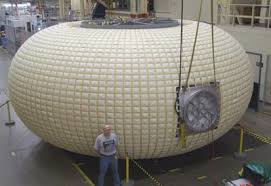Inflatable space habitats could be key to exploring the solar system (Courtesy of Space Insider) — It’s high time to crank up the volume in space! That’s the shout from several private firms that want to see an inflation factor for the future.
What is now being evaluated and tested is the use of “softgoods” to fashion inflatable/expandable airlocks and off-Earth habitats, not only for low Earth orbit, but also to provide comfy housing for future moon and Mars explorers.
First, however, there’s a memory lane trip about this idea worth taking, one that also underscores how far things have evolved.
The roots of inflatable space tech
Take for example, Project Echo, which involved two American spacecraft, the first launched in 1960 and the second in 1964. They were thin-skinned Mylar balloon satellites. These gassed-up balloons — Echo 1 expanded to 100 feet (30.48 meters), while Echo 2 inflated to 135 feet (41 m) — tested the reflection of microwave signals from one point to another on Earth.
Then, in March 1965, Soviet cosmonaut Alexei Leonov made use of an inflatable airlock attached to his Voskhod 2 spacecraft to carry out humanity’s first spacewalk. But that milestone turned out to be no stroll in the park.
The tethered Soviet spacewalker’s suit stiffened so much in the vacuum of space, Lenov had to bleed off some of his suit’s pressure, allowing him to finally bend the spacesuit joints to clamor back into his mothership.
Bigelow birthright
Enter the 21st century and the pioneering work of Robert Bigelow and his team at Las Vegas-based Bigelow Aerospace.
The company built two uncrewed free-flying expandable prototype modules that launched to Earth orbit in 2006 and 2007, respectively, under its Genesis program. They are still circling the globe to this day.
While drawing from NASA’s canceled TransHab effort, the Bigelow Aerospace enterprise was a creative hub that furthered expandable space module technology.
An outgrowth of their labor is now attached to the International Space Station (ISS). The Bigelow Expandable Activity Module, or BEAM for short, arrived at the ISS and remains attached to its Tranquility module to this day.
Bigelow Aerospace and its ground-breaking work in expandable modules included use of proprietary extensions of Vectran shield fabric, a stronger alternative to Kevlar. Vectran is a high-performance liquid crystal polymer fiber offering superior attributes compared to Kevlar.
Bigelow is no longer operating — the company closed its doors in 2020 — but its influence may still be felt going forward.
Today, several leading firms are pushing forward on expandable structures in space, such as the new startup Max Space, which is working on inflatable habitats for Earth orbit, the moon and Mars.
And Sierra Space is involved as well, developing a habitat called the Large Integrated Flexible Environment (LIFE).
Similarly, Lockheed Martin is testing inflatable structure concepts that offer advantages over all-metal counterparts.
Each group is eyeing the promising potential for expandable technology. And each company has its own proprietary “secret sauce” embedded in their products.
Jacksonville’s Max Space
“The future of space is limited by space,” explained Maxim de Jong, co-founder of Max Space, based in Jacksonville, Florida with design offices in Vancouver, Canada.
No stranger to expandable space structures, de Jong designed the pressure restraining hulls of Bigelow’s Genesis 1 and 2 — the first spacecraft on orbit to successfully incorporate large-volume, high-stress inflatable architecture.
“We are gearing up to fly our maiden mission in 2026,” de Jong told Space.com. Within that process, the group has recently performed successful deployment tests of a new space debris shield design. “That is a real progress discriminator, given how challenging, in terms of design, time and cost, debris shield development is.”
The Max Space goal is to have a family of scalable habitats in space, ranging from 20 cubic meters (700 cubic feet) to 100 cubic meters (3,500 cubic feet) to 1,000 cubic meters (35,000 cubic feet) thru 2030. There’s the potential to scale up to 10,000-cubic-meter (350,000 cubic feet) “megastructures” that could be launched into space on a single flight, using SpaceX’s Starship megarocket or Blue Origin’s New Glenn, “once they’re online,” the Max Space website states.
Photo courtesy of NASA

